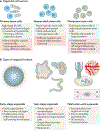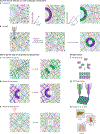Engineered materials for organoid systems
- PMID: 33552558
- PMCID: PMC7864216
- DOI: 10.1038/s41578-019-0129-9
Engineered materials for organoid systems
Abstract
Organoids are 3D cell culture systems that mimic some of the structural and functional characteristics of an organ. Organoid cultures provide the opportunity to study organ-level biology in models that mimic human physiology more closely than 2D cell culture systems or non-primate animal models. Many organoid cultures rely on decellularized extracellular matrices as scaffolds, which are often poorly chemically defined and allow only limited tunability and reproducibility. By contrast, the biochemical and biophysical properties of engineered matrices can be tuned and optimized to support the development and maturation of organoid cultures. In this Review, we highlight how key cell-matrix interactions guiding stem-cell decisions can inform the design of biomaterials for the reproducible generation and control of organoid cultures. We survey natural, synthetic and protein-engineered hydrogels for their applicability to different organoid systems and discuss biochemical and mechanical material properties relevant for organoid formation. Finally, dynamic and cell-responsive material systems are investigated for their future use in organoid research.
Figures




References
-
- Harrison RG, Greenman MJ, Mall FP & Jackson CM Observations of the living developing nerve fiber. Anat. Rec 1, 116–128 (1907).
-
- Ishii K. Reconstruction of dissociated chick brain cells in rotation-mediated culture. Cytologia (Tokyo) 31, 89–98 (1966). - PubMed
Grants and funding
LinkOut - more resources
Full Text Sources
Other Literature Sources
